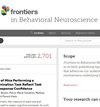通过连续运动活动监测评估小鼠颅内手术后的动物福利
IF 2.6
3区 医学
Q2 BEHAVIORAL SCIENCES
引用次数: 0
摘要
运动活动可作为识别不适和疼痛的读数。因此,在采取可能引起不适的干预措施后监测运动活动可作为评估动物健康状况的一种可靠方法,是对体重测量等传统方法的补充。在这项研究中,我们使用数字通风笼(DVC®)系统对阿尔茨海默病小鼠模型(C57BL/6J/APPswe/PSEN1dE9)进行颅内立体定向手术后的昼夜节律运动活动进行了评估,同时还进行了体重监测。立体定向手术并未影响 7-8 周龄和 19-21 周龄小鼠的昼夜节律运动组织。但是,我们观察到,年轻和年老的小鼠在黑暗阶段的活动都明显减少。此外,我们的研究还表明,与测量体重相比,运动活动的变化在检测动物健康状况变化方面具有更高的灵敏度。在7-8周龄的小鼠中,我们没有观察到运动活动的基因型差异,相比之下,19-21周龄的APP/PS1小鼠与野生型小鼠相比,运动活动有所增加。此外,我们的分析还发现,7-8周龄的小鼠中有一部分在黑暗阶段的最初高峰期表现出运动活动增加。有一只小鼠可能因癫痫发作而在生命早期猝死。总之,我们的研究结果肯定了 DVC® 中使用的连续活动测量是一种非常有价值的手术后福利监测客观方法。它的辨别能力不仅有助于昼夜节律评估,而且还能识别个别异常活动模式,这可能是癫痫发作的征兆。本文章由计算机程序翻译,如有差异,请以英文原文为准。
Continuous locomotor activity monitoring to assess animal welfare following intracranial surgery in mice
Locomotor activity can serve as a readout to identify discomfort and pain. Therefore, monitoring locomotor activity following interventions that induce potential discomfort may serve as a reliable method for evaluating animal health, complementing conventional methods such as body weight measurement. In this study, we used the digital ventilated cage (DVC® ) system for the assessment of circadian locomotor activity, in addition to body weight monitoring, following intracranial stereotaxic surgery in an Alzheimer’s disease mouse model (C57BL/6J/APPswe/PSEN1dE9). Stereotaxic surgery did not affect the organization of circadian locomotor activity of both 7–8-week-old and 19–21-week-old mice. However, we observed that both young and old mice exhibited a significant decrease in activity during the dark phase. Also, our study shows that changes in locomotor activity exhibit higher sensitivity in detecting alterations indicative of animal health compared to measuring body weight. In contrast to 7–8-week-old mice, where we observed no genotypic differences in locomotor activity, 19–21-week-old APP/PS1 mice showed increased locomotor activity compared to wild-type mice. Furthermore, our analyses revealed that a subset of the 7–8-week-old mice showed increased locomotor activity during the initial peak of the dark phase. One mouse experienced sudden death early in life, possibly due to epileptic seizures. Altogether, our findings affirm continuous activity measurements as used in the DVC® as a highly valuable objective method for post-surgical welfare monitoring. Its discerning capacity not only facilitates circadian locomotor rhythm assessment but also enables the identification of individual aberrant activity patterns, possibly indicative of epileptic seizures.
求助全文
通过发布文献求助,成功后即可免费获取论文全文。
去求助
来源期刊

Frontiers in Behavioral Neuroscience
BEHAVIORAL SCIENCES-NEUROSCIENCES
CiteScore
4.70
自引率
3.30%
发文量
506
审稿时长
6-12 weeks
期刊介绍:
Frontiers in Behavioral Neuroscience is a leading journal in its field, publishing rigorously peer-reviewed research that advances our understanding of the neural mechanisms underlying behavior. Field Chief Editor Nuno Sousa at the Instituto de Pesquisa em Ciências da Vida e da Saúde (ICVS) is supported by an outstanding Editorial Board of international experts. This multidisciplinary open-access journal is at the forefront of disseminating and communicating scientific knowledge and impactful discoveries to researchers, academics, clinicians and the public worldwide.
This journal publishes major insights into the neural mechanisms of animal and human behavior, and welcomes articles studying the interplay between behavior and its neurobiological basis at all levels: from molecular biology and genetics, to morphological, biochemical, neurochemical, electrophysiological, neuroendocrine, pharmacological, and neuroimaging studies.
 求助内容:
求助内容: 应助结果提醒方式:
应助结果提醒方式:


